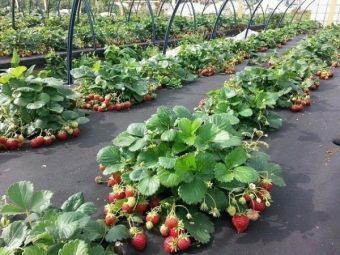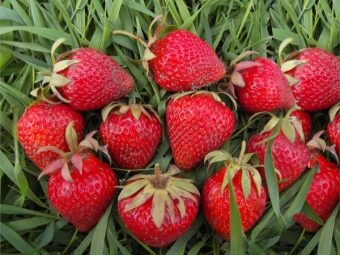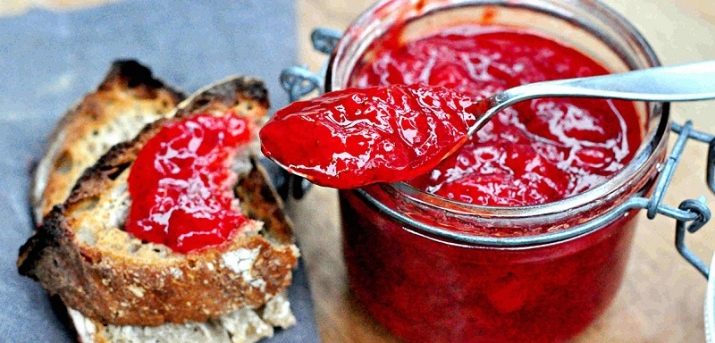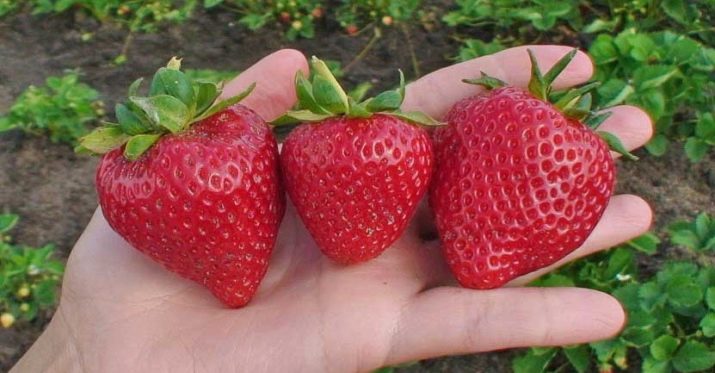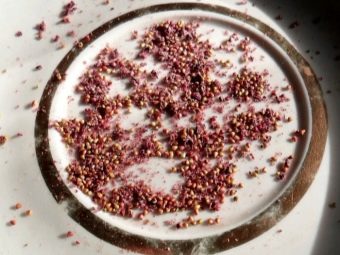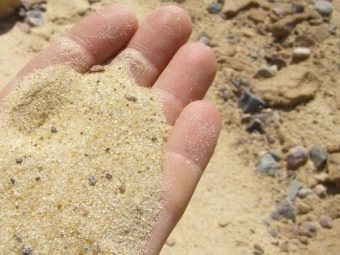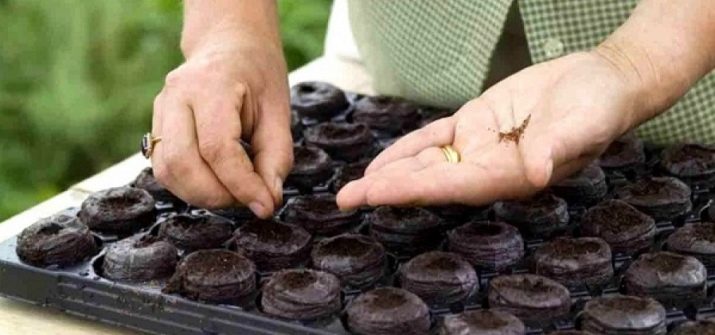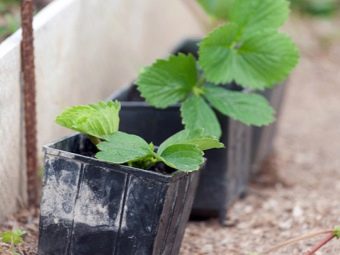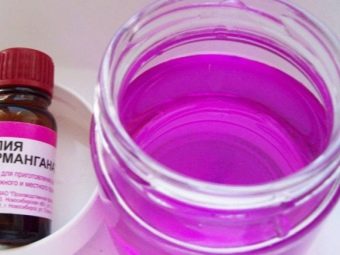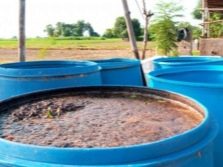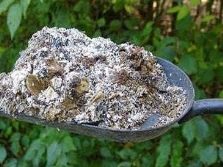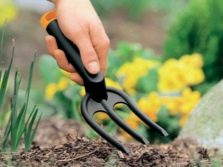Strawberry "Lambada": description of the variety and agricultural technology

The most common berry grown on private land is strawberry.Many varieties of garden strawberries are cultivated in Russia. Each species has specific characteristics, advantages and disadvantages. Among the great diversity it is worthwhile to dwell on the strawberry variety “Lambada”.
Description
Bush
This variety belongs to the class of super early varieties, however, this characteristic may vary depending on the climate in the growing region. As a rule, the ripening period of berries falls on the middle of May or the end of spring. Gardeners and gardeners fell in love with this variety for simplicity in care. To get a rich harvest you do not need to care for the plant daily. For shrubs characterized by high growth and spreading.
One of the main differences of the species is that there are few leaves on the bush. Color - standard, rich green. Peduncles differ in size and power. In the period of flowering shrub richly covered with buds. The appearance of the flowers is the same as in most varieties of strawberries - white petals and a yellow heart. It is worth noting that this variety was bred by the efforts of Italian breeders in 1982. In Russia, the species is grown both on open ground and in greenhouses or greenhouses.
Fruit
Berries varieties "Lambada" pleasantly surprised by the size. The average weight of one fruit is about 40 grams. The shape may be different, but, as a rule, strawberries are round-conical. In the process of ripening berries are painted in bright scarlet color. Juicy pulp has the same color. If you cut a ripe fruit, white streaks you can not see. Due to the large size to pick berries is very convenient. Tastes excellent - sweetness without signs of sourness.
Advantages and disadvantages
Professional agronomists and ordinary gardeners who are engaged in growing fruit crops in country houses and private gardens, distinguish such positive qualities of this class as:
- berries ripen early;
- ripe strawberries have the same size;
- fruits are ideal for making jam, jam, or a tasty and healthy compote, and they are recommended to be used as a fresh food;
- berries are remarkably stored in the freezer, while maintaining taste and benefits;
- shrubs can tolerate frosts up to 30 degrees Celsius below zero, even without a full cover; due to this characteristic, it is possible to grow a crop within the regions with a harsh climate, but in this case it is necessary to further protect the plants;
- Lambada variety has strong immunity, protecting it from various diseases;
- in spite of the fact that the yield index is not only the highest, experts note stable fruiting;
- excellent gastronomic qualities;
- due to the formation of many antennae to propagate the plant is not difficult;
- due to the large size of the berries, the fruit picking process is quick.
After the designation of positive qualities, it is necessary to note the weak points of the variety. This view has the following several disadvantages.
- Berries do not tolerate transportation. In the process of transportation, they lose an attractive presentation. And also they quickly come into disrepair if stored without a refrigerator.
- The formation of a multitude of whiskers serves both as an advantage and a disadvantage. They greatly complicate the process of caring for the plant. During the growing season, you should constantly get rid of them.
After analyzing the above information, it is safe to say that the shortcomings in the variety are insignificant and positive qualities completely overlap them.
Breeding
Two methods of plant reproduction are distinguished: using seeds and using antennae. Each of the options has its own characteristics. Experienced gardeners claim that strawberry planting should be regularly updated every 2-3 years.When choosing a method of reproduction, most lean in favor of seed, with which you can get a strong, strong seed. However, breeding with antennae has its advantages.
Seeds
This technique has certain difficulties. The first thing that gardeners and gardeners face is that it takes a long time to grow seed. For a long time shoots complicates and delays the process of growing. And it is also necessary to stratify, otherwise the seeds may not germinate at all. Material for sowing prepared throughout the month, for this the seeds are mixed with sand and put in the refrigerator.
Grains are planted in the winter, from the end of the second winter month to the beginning of February. Professionals advise you not to deepen the seeds in the soil, simply lay them out on moist soil. For germination use boxes. They are covered with glass and left in a warm room where the temperature totals up to +25 degrees Celsius. As soon as the first shoots become noticeable, the glass panels slightly open, they should not be completely removed.
A pick of a seedling begins as soon as a few true leaves appear on a plant (2-3 pieces). While working, care should be taken not to damage the roots. Experts strongly recommend growing strawberry seedlings in special peat tablets. In this case, when a plant is transplanted to a new place, the berry will not survive stress and will take root on the site without any problems. Shrubs are transplanted to a permanent place with the arrival of spring.
Work is carried out only when the air and the earth warms up, and night frosts recede. To save time and effort, you can buy ready-made seeds in garden stores, but in this case there is no confidence in its quality.
Breeding with antennae
During the growing season, the antennae form in large quantities. As a rule, excess material is removed, since its number is several times the required amount. Experts advise to leave brood hives used exclusively for breeding. The formation of "kids" reduces the rate of yield, taking power from the bush. Outlets are capable of rooting independently.
To help strawberries, you can cover the soil under them or transfer them to a separate hotbed for the development of the root system. Planting antennae comes with the arrival of autumn.
Landing features
A rich, stable and high-quality harvest depends on a variety of processes. One of them is planting shrubs. During work, you must follow certain rules that affect the development of the plant and its further fruiting. Experienced gardeners say that this variety feels great in the open shadow. Such conclusions were made by summer residents who have been cultivating this species for several years.
If you want to achieve maximum yield, you should choose a site filled with sunlight. It is necessary to ensure that the landing site was protected from strong winds. Strawberry "Lambada" loves loamy soil with a slightly acid or neutral reaction. The main characteristic for soil is fertility and saturation with beneficial elements. Shrubs will develop properly on air-permeable soils.
If the plant is planted in salty soil, the process of its growth will be significantly slowed down.
How to prepare seedlings?
If planting material that was grown on its own is used, it does not need careful preparation. Another thing - seedlings acquired in the market. To disinfect the shrubs, they are treated with a pink solution of potassium permanganate. Plants are immersed in the composition for 10 minutes, and then washed with water. During planting, the seedling heart cannot be deepened; it should be placed above the soil.
Before planting, the soil around the roots is compressed to get rid of air pockets. The optimal distance between the bushes is about 40 centimeters. Watering plants can only be at the root. Strawberry likes abundant hydration. After this, mulching is carried out. The following organic matter is used: humus, peat, straw, fermented sawdust (fresh cannot be used).
Care rules
It is necessary to adhere to several basic rules of care from experienced gardeners.
- It is necessary to regularly loosen the land around shrubs. Care should be taken not to damage the roots.
- Do not allow the drying of the upper layers of the soil, while not over-wetting the ground. During flowering, watering should be reduced, it is recommended to use warm water.
- The soil is fertilized several times in one season. When ripe, you can not use mineral compounds. The best solution is organic. Most often, litter, mullein, green truck and wood ash are introduced. Apply both root and foliar method of fertilizer. Some useful elements of the strawberry perfectly assimilates through the foliage.
- Despite strong immunity and resistance to disease, preventive measures will not be superfluous. The most common problems with growing are slugs and birds.
- After harvesting, the leaves are removed, keeping the growing point. To shrubs survived the winter, they feed them. It is recommended that treatment be carried out using 2% Bordeaux liquid.
Gardeners reviews
Due to the popularity of the variety in the network, you can find many reviews of Russian and foreign summer residents. A significant portion of all feedback is positive. Both beginners and experts noted the qualities indicated in the “Pros” section. The main advantage of gardeners noted the excellent taste and the earlier ripening of berries.
Negative feedback is also available. Due to the poor portability of shipments, it is better to refuse this variety to those who intend to grow strawberries for sale.
For information on how to care for strawberries in spring, summer and autumn, see the following video.

